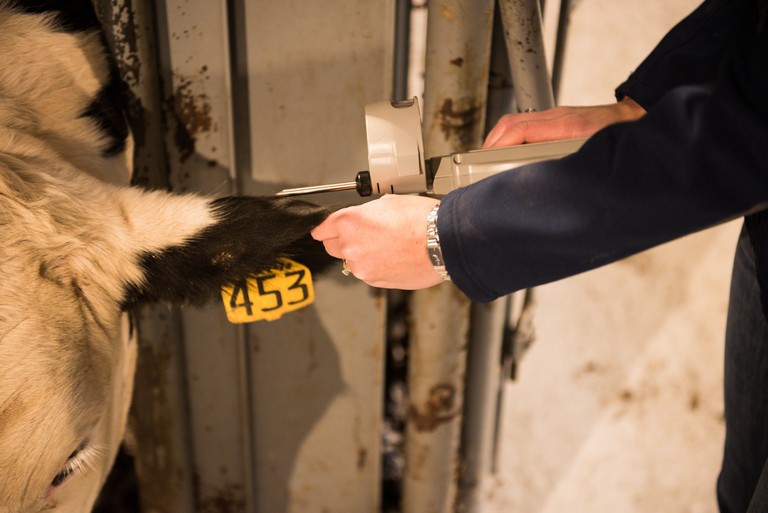Additional 10% meat yield from Holstein steers can be difference between surviving and going under for dairy farm grappling with low milk prices.
February 14, 2020

Holstein steers that get hormone implants grow faster than those that do not receive the implants, and they get as big as beef cattle breeds, according to researchers at The Pennsylvania State University who said that's good news for dairy farmers struggling to keep their operations financially viable.
In one of the first studies to track the effects of hormone implants in Holsteins — and in what is believed to be the only study to track hormone levels in their blood and muscles — researchers closely followed the development of 70 Holstein steers in an experiment at the Pennsylvania Department of Agriculture’s Livestock Evaluation Center, the university said in an announcement.
The study is important because Holsteins — traditionally considered dairy cattle — now supply up to 20% of the beef market in the U.S., according to assistant professor of animal science Tara Felix in the Penn State College of Agricultural Sciences.
The research was aimed at determining the effect of steroidal implants on growth performance, carcass characteristics and estradiol-17 beta concentrations in the blood and muscles of Holstein steers fed a grain-based diet.
The research team, led by Pedro Henrique Vilela Carvalho, a doctoral student in the department of animal science, also assessed how long and how strongly the hormones influenced the growth of Holstein steers after implantation — evaluating the so-called payout period when producers can expect the hormone to boost growth, the announcement said.
Hormone implants have been used in beef cattle production to improve growth performance and feed efficiency for more than 50 years, and 90% of all feedlot cattle in the U.S. receive implants, noted Felix, who's also the beef cattle specialist for Penn State Extension. “Most of the available data on implants was collected in studies conducted on beef breeds,” she said. “So, we focused on technology to enhance Holstein beef production.”
In findings published recently in the Journal of Translational Animal Science, the researchers reported that Holstein steers responded to hormone implants very similarly to beef breed steers. The study revealed that implanted Holstein steers had about a 10% increase in weight gain and feed intake over Holstein steers that were not implanted. In addition, carcasses from implanted Holstein steers were about 10% heavier, on average, and loin muscle area increased compared to carcasses from non-implanted steers, the researchers reported.
That additional 10% meat yield from Holstein steers can be the difference between surviving and going under for a dairy farm grappling with low milk prices and declining demand, Felix noted.
“Dairy steers are a byproduct of milk production,” she said. “A cow has to have a calf to produce milk. This sounds cruel, but we don't necessarily need that calf for milk production. If it's a female -- a heifer -- we use it as a replacement animal to make more milk. If it's a male -- or a bull calf -- then we turn it into a steer and ‘finish it’ -- or feed it a high-grain diet -- to improve its beef qualities.”
Holstein steers have become important to U.S. beef production over the last decade, Felix said. In 2011, just 5% of cattle finished in the U.S. were Holsteins, but in 2016, that figure had risen to 20% of finished cattle — a 400% increase in just five years.
“There are a number of reasons for this, but one of the biggest reasons was that dairy producers were struggling during that same time frame, and they were looking for ways to make more money on these steers,” Felix said. “Beef from Holsteins is not just ground. More than 80% of the animals that were in this trial, regardless of whether or not they received an implant, graded [U.S. Department of Agriculture] Choice or above, which means they likely became premium steaks.”
Hormone use in beef cattle production continues to be an uncomfortable topic for Americans, Felix explained. The average consumer doesn't understand the production supply chain and is subjected to misinformation, she argued.
“There are always hormones in food we eat; all living things have hormones,” she said. “There is even a difference in hormone levels, depending on whether beef comes from a steer or a cow. Beef from females often has twice the hormone activity.”
Felix pointed out that something as common as a potato has 300 times the hormone activity as a serving of beef. Other foods that have more estrogenic activity than beef are beans, peas and tofu — common protein substitutes for meat in the human diet.
“All of these hormones are ‘natural,’ and there is no such thing as hormone free when it comes to the meat we eat, but that doesn’t mean any of these foods are dangerous because of the hormone activity, and that includes meat,” she said.
South Dakota State University professor George Perry was also involved in the research, which was supported by JBS USA, the Pennsylvania Beef Producers Working Group and the Pennsylvania Department of Agriculture staff at the Livestock Evaluation Center.
You May Also Like


.png?width=300&auto=webp&quality=80&disable=upscale)
